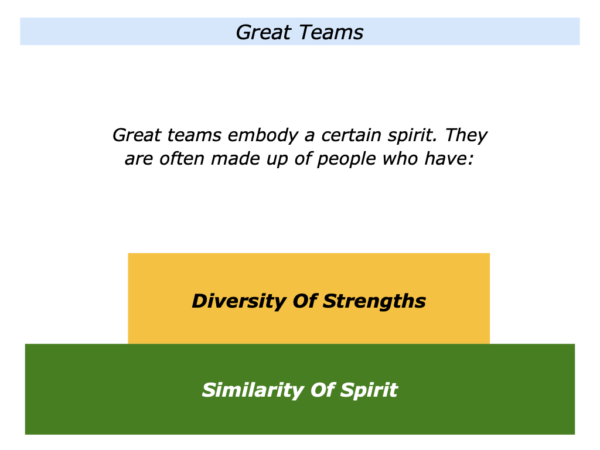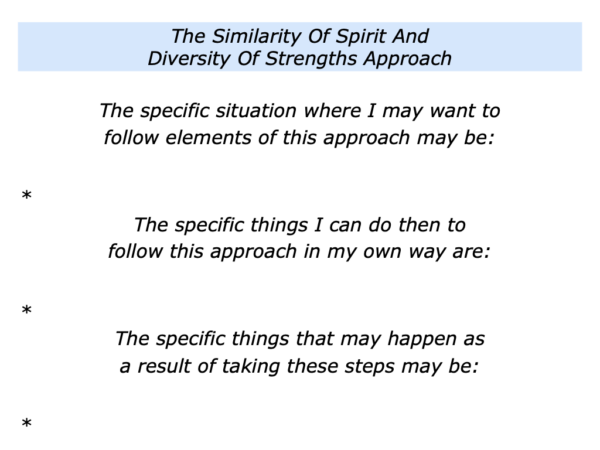
Great teams embody a certain spirit. They are also often made up of people who have similarity of spirit and diversity of strengths. Diversity of spirit is a recipe for disaster.
Spirit gets people so far. But it is the diversity of strengths that enables them to produce something special when it matters.
Such teams start by defining the spirit – the principles – they want people to demonstrate. Attitude is non-negotiable but they want characters not clones. They also recognise that people will express the spirit in different ways but they need to always demonstrate high professional standards.
Great teams often employ people who have a positive attitude. They then encourage them to use their strengths to follow certain principles and do their best to achieve the picture of success. Let’s explore how some of these themes relate to individuals, teams and organisations.
A Person’s Spirit
Different people have different kinds of spirit. They may demonstrate this in the way they behave and the effect they have on other people. For example, they may be:
Generous, kind and encouraging … Caring, creative and a bit crazy … Cruel, selfish and mean.
How to define a person’s spirit? One approach is to do the following exercise. This involves doing three things.
First, write the name of the person. Second, write three words that you believe describe the person’s spirit. Third, describe some of the ways that they translate this spirit into action.
This approach is subjective, of course, and other people may use different words to describe the person. But it can be a starting point. Here is the exercise.
The Person’s Name Is …
The three words I would use
to describe their spirit are:
*
*
*
The specific ways they translate
this spirit into action are:
*
*
*
A Team’s Spirit
Different teams also demonstrate different kinds of spirit. People who work in a hospice, for example, may follow different principles from those in a sports team or financial institution.
The team’s spirit will shape the culture and the effects this has on people. For example, the culture it creates may be either:
Caring, compassionate and people focused … Positive, professional and peak performing … Competitive, cold and callous.
Imagine that you lead a team. Try exploring the following themes.
What may be the kind of spirit that you want people to demonstrate in the way they behave and work?
How would they translate this spirit into action?
What may be the reasons why you would like people to demonstrate this kind of spirit?
If you wish, try tackling the exercise on this theme. This invites you to complete the following sentences.
The Team’s Spirit
The spirit we would like people
in our team to demonstrate is:
*
*
*
The specific ways they would
translate this spirit into action would be:
*
*
*
The reasons why we would like
people to demonstrate this spirit are:
*
*
*
Imagine that you lead a team and want to follow elements of this approach. Let’s explore two ways you can make this happen.
The Recruiting
For Spirit Approach
There are many ways to recruit people. One approach is to clarify whether a person has the right spirit and strengths to help a team or organisation to achieve its picture of success. They may therefore take the following steps.
They start by clarifying the spirit
they want people to demonstrate
Imagine that you have already clarified the spirit – the principles or professional standards – you want people to demonstrate. If so, you can move onto the next theme followed by some teams and organisations.
They clarify whether a candidate may have
the spirit they want people to demonstrate
One organisation I worked with took the following steps when interviewing people. They sent the candidate a booklet that described:
The specific principles they wanted people in the organisation to follow;
The specific reasons why they wanted people to follow these principles;
The specific ways that these principles could be translated into action.
The booklet was illustrated with examples and success stories that showed how employees had followed the principles in their daily work.
The candidate was invited to do some prework which they then presented at the interview. They were asked:
To describe a specific time in when they had aimed to follow one of the principles – this could be in their personal or professional life;
To describe the specific things they did to translate the principle into action;
To describe the specific things they would do to aim to follow this principle in their work in the organisation.
This sounds an enormous task but it was vital. Some candidates rose to the challenge, others did not. The organisation saw recruitment as one of its most important tasks. It looked for people who took responsibility and aimed:
To have a positive attitude;
To help other people – such as customers and colleagues – to succeed;
To keep developing as professionals
The organisation aimed to recruit such people and involve them in a positive induction process. They then made decisions about the person’s future towards the end of the probationary period.
The decision they made was often based on the following themes – Spirit, Strengths and Success. It involved asking the following questions.
Spirit
Does the person have the spirit we want people to demonstrate to help us to achieve success?
Strengths
Does the person have certain strengths that can contribute to helping us achieve success?
Success
Does the person have the desire to apply these strengths to help us to achieve success?
The organisation found this approach often proved to be successful. Let’s look at another approach that encourages people to demonstrate a certain kind of spirit.
The Success Stories Approach
Some teams and organisations aim to reward the behaviour they want repeated. They continually publish success stories that highlight when people have demonstrated the required spirit. The aims are:
To keep showing people what good looks like when the spirit – such as the principles – are translated into action;
To show people the benefits – to all the various stakeholders – of following these principles;
To encourage people to apply their strengths to follow these principles in the future and help the organisations to achieve success.
Great teams continue to follow the similarity of spirit and diversity of strengths approach. They encourage people to follow the principles and coordinate their professional strengths to deliver sustainable success.
Let’s return to your own work. Can you think of a situation where you may want to follow elements of this approach? How can you do this in your own way?
If you wish, try tackling the exercise on this theme. This invites you to complete the following sentences.







Leave a Reply